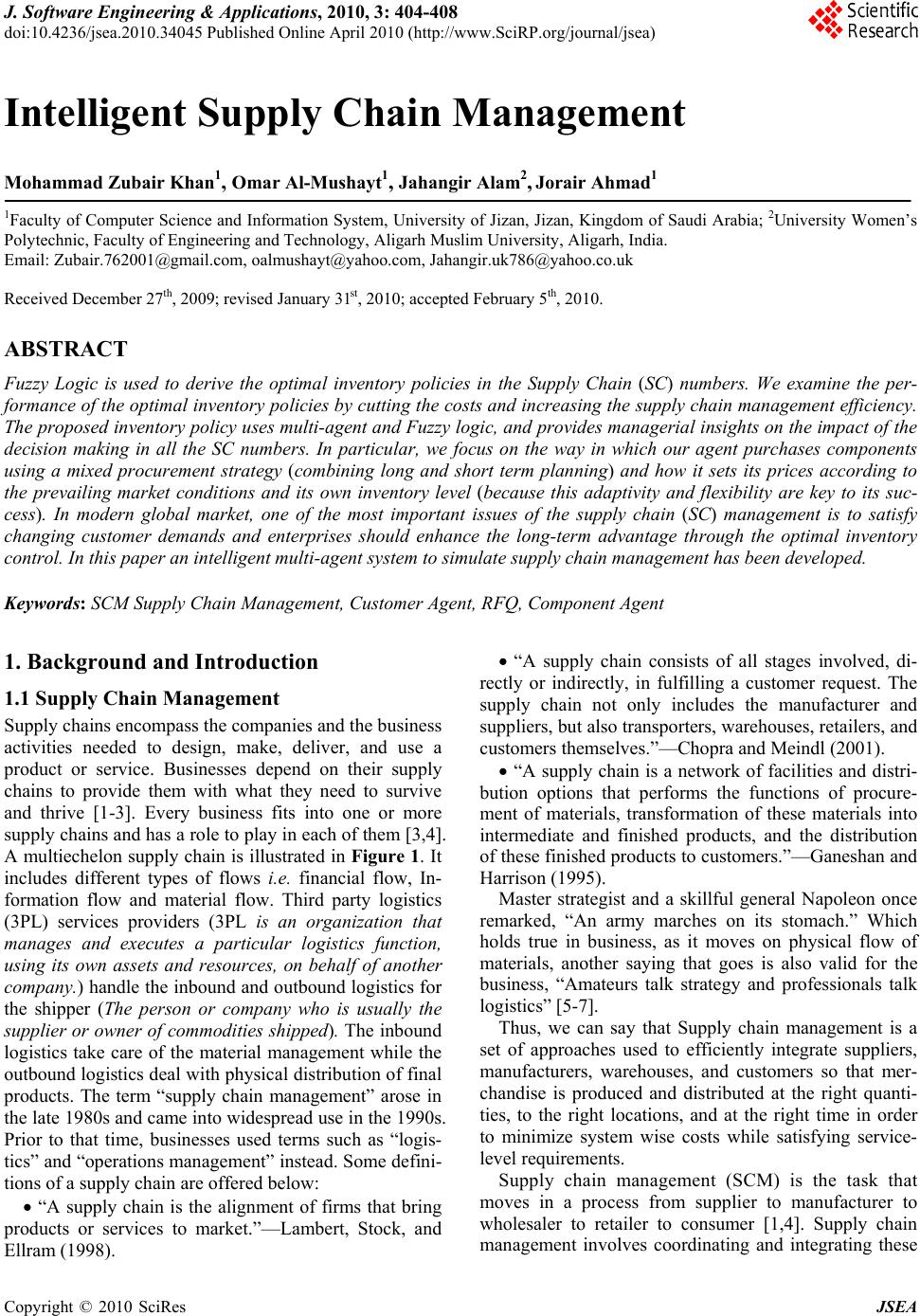
J. Software Engineering & Applications, 2010, 3: 404-408
doi:10.4236/jsea.2010.34045 Published Online April 2010 (http://www.SciRP.org/journal/jsea)
Copyright © 2010 SciRes JSEA
Intelligent Supply Chain Management
Mohammad Zubair Khan1, Omar Al-Mushayt1, Jahangir Alam2, Jorair Ahmad1
1Faculty of Computer Science and Information System, University of Jizan, Jizan, Kingdom of Saudi Arabia; 2University Women’s
Polytechnic, Faculty of Engineering and Technology, Aligarh Muslim University, Aligarh, India.
Email: Zubair.762001@gmail.com, oalmushayt@yahoo.com, Jahangir.uk786@yahoo.co.uk
Received December 27th, 2009; revised January 31st, 2010; accepted February 5th, 2010.
ABSTRACT
Fuzzy Logic is used to derive the optimal inventory policies in the Supply Chain (SC) numbers. We examine the per-
formance of the optimal inven tory policies by cutting the costs and increa sing the supply chain management efficiency.
The proposed inventory policy uses multi-agent and Fu zzy logic, and provides managerial insights on the impact of the
decision making in all the SC numbers. In particular, we focus on the way in which our agent purchases components
using a mixed procurement strategy (combining long and short term planning) and how it sets its prices according to
the prevailing market conditions and its own inventory level (because this adaptivity and flexibility are key to its suc-
cess). In modern global market, one of the most important issues of the supply chain (SC) management is to satisfy
changing customer demands and enterprises should enhance the long-term advantage through the optimal inventory
control. In this paper an intelligent multi-agent system to simulate supply chain man agement has bee n dev elo ped .
Keywords: SCM Supply Chain Management, Customer Agent, RFQ, Component Agent
1. Background and Introduction
1.1 Supply Chain Management
Supply chains encompass the companies and the business
activities needed to design, make, deliver, and use a
product or service. Businesses depend on their supply
chains to provide them with what they need to survive
and thrive [1-3]. Every business fits into one or more
supply chains and has a role to play in each of them [3,4].
A multiechelon supply chain is illu strated in Figure 1. It
includes different types of flows i.e. financial flow, In-
formation flow and material flow. Third party logistics
(3PL) services providers (3PL is an organization that
manages and executes a particular logistics function,
using its own assets and resources, on behalf of another
company.) handle the inbound and outbound logistics for
the shipper (The person or company who is usually the
supplier or owner of commodities shipped). The inbound
logistics take care of the material management while the
outbound logistics deal with physical distribution of final
products. The term “supply chain management” arose in
the late 1980s and came into widespread use in the 1990s.
Prior to that time, businesses used terms such as “logis-
tics” and “operations management” instead. Some defini-
tions of a supply chain are offered below:
“A supply chain is the alignment of firms that bring
products or services to market.”—Lambert, Stock, and
Ellram (1998).
“A supply chain consists of all stages involved, di-
rectly or indirectly, in fulfilling a customer request. The
supply chain not only includes the manufacturer and
suppliers, but also transpo rters, warehouses, retailers, and
customers themselves.”—Chopra and Meindl (2001).
“A supply chain is a network of facilities and distri-
bution options that performs the functions of procure-
ment of materials, transformation of these materials into
intermediate and finished products, and the distribution
of these finished products to customers.”—Ganeshan and
Harrison (1995).
Master strategist and a skillful general Napoleon once
remarked, “An army marches on its stomach.” Which
holds true in business, as it moves on physical flow of
materials, another saying that goes is also valid for the
business, “Amateurs talk strategy and professionals talk
logistics” [5-7].
Thus, we can say that Supply chain management is a
set of approaches used to efficiently integrate suppliers,
manufacturers, warehouses, and customers so that mer-
chandise is produced and distributed at the right quanti-
ties, to the right locations, and at the right time in order
to minimize system wise costs while satisfying service-
level requirements.
Supply chain management (SCM) is the task that
moves in a process from supplier to manufacturer to
wholesaler to retailer to consumer [1,4]. Supply chain
management involves coordinating and integrating these